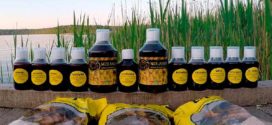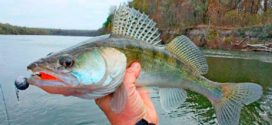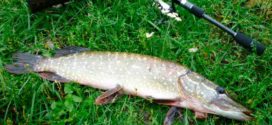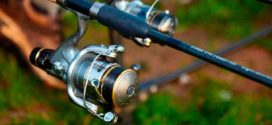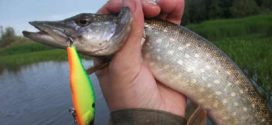Kwoks are often used to attract catfish to bait. With their help, sound vibrations are created in the water, attracting predatory fish. But fishing on a kwok will be effective only with the right choice of model, gear and fishing location. This lure is intended only for catching fish from a boat or other watercraft.
Content
Design and selection recommendations
Basically, a kwak is a wooden or steel mallet that makes a sound when it hits the surface of the water. It consists of three components - a handle, a knife and a snout. The first is necessary to fix the kwok in the palm of your hand. The knife is designed to deepen the patch into the water, it must be thin so that there is no resistance. Piglet is a slightly concave oval plate. During the dive, some air remains in it, which makes a sound when it exits the water.
Basic recommendations on how to choose a kwak for fishing:
- Production material - wood or metal. The best choice is a wooden handle, a knife and a metal snout. Completely wooden models can break quickly.
- The angle between the handle and the knife part is from 40° to 45°. This is enough to form a large span of the arc before the patch enters the water.
- Blade thickness is minimal.
The main criterion is ease of use. Many fishermen buy several models to test how effective quok fishing will be. Take into account the height of the boat, the length of the arms. Knowing what a kwok is and familiarizing yourself with the specifics of the design, you can begin to make it yourself.
How to DIY
The main conditions for kwak are ease of use and the required performance. The handle is best made from wood, and the knife and heel are made from metal. Steel is more reliable, it is possible to achieve a minimum thickness while maintaining strength. It is recommended to choose stainless steel grades, as quoks will often be exposed to water.
Making a quok can be divided into the following stages:
- Preparatory. Workpieces are selected for all components, their dimensions are adjusted according to the drawing.
- Pen. Form with recesses for the fingers, width - about 30 mm. A cutout is made in the lower part for attaching a knife, in the upper part there is a hole for a loop. It is necessary that during fishing the cracker does not fall into the water.
- Knife with a bend, tapering to the point of attachment of the patch. Recommended length - up to 22 cm.
- Heel width - up to 25 mm.
When attaching all components, you need to track the angle between the water cutter and the handle. The appearance and smoothness of the transition from one component to another does not matter. To improve the fixation of the handle and palm, it is recommended not to grind the first one, but to make small notches on its surface. The best option is to upholster it with leather.
Tackle selection
Since quoki is an auxiliary bait for catfish, you need to choose the right tackle for fishing. Fishing will be from a boat, so choose short rods or use a reel for fishing line. Take into account the mass of potential prey. For catching trophy catfish, you need to choose the appropriate equipment.
To catch catfish on a kwok, you will need the following gear:
- Rod. You can stop at carp or marine models with a maximum length of up to 3 m. The tackle should be of medium hardness, the maximum load depends on the mass of the fish.
- Coil. A frequent option is inertial models with a spool size over 5000. With a powerful bite, it is recommended to use only a baitrunner.
- Fishing line - monofilament or braided line. It is important to choose the right model with the required breaking force.
- Sinker weighing up to 30 g. Mounting methods - sliding or fixed.
- A leash with a lower breaking force. A single or double hook is attached to it.
When fishing on a wak, convenience is important. The fisherman will have to simultaneously monitor the equipment and use the kwok on the catfish. You can try to do this on the shore before the start of fishing, in case of discomfort, make changes to the tackle.
Fishing spots
The natural habitat of catfish is deep pits and drops in bottom topography. Sometimes he can hunt near the shore. It depends on the depth of the reservoir and the presence of potential predator prey. You can catch a truly large specimen only in deep places of rivers and lakes.
An echo sounder or navigator is used to search for holes. Some fishermen use the old method - they check with a long pole.
Places with a high probability of catching catfish on kwak:
- Places of rivers, the banks of which have steep slopes. This indicates considerable depth in this part.
- In whirlpools located far from the coastal zone.
- Spills, but only if they abound with living creatures and vegetation.
Active fishing is observed from early May to mid-June. The predator is actively gaining mass after hibernation and reacts energetically to the sounds of a quok. A good bite starts from mid-autumn, but not the same as spring. It will take endurance and frequent changes in the position of the boat to lure the catfish.
The video shows how to properly catch a trophy catfish using this technology:
Catfish Catching Method
You can learn how to catch catfish on a kwok only after a few trials. All factors affecting the probability of a catch are taken into account. If you are fishing on the river, it is recommended to add a water sail to the boat equipment. It will slow down the current, minimizing the need for oars or a motor.
Technology for catching catfish on a kwok from a boat:
- The penny is behind.
- The optimal angle of entry into the water is 45°.
- At the lowest point of immersion, the knife assumes a vertical position.
- By moving backwards and upwards, the kwak emerges from the water. This must be done sharply so that a characteristic croaking sound appears.
This technology has not been developed for a long time. It is important to use the hand correctly - it affects the speed of the wok's exit from the water.
After a few claps, the behavior of the tackle is monitored. Bite can begin in 3-5 minutes. Usually you have to wait about 15-20 minutes. If during this time no characteristic movement was noticed on the surface of the water, it is recommended to change the place of fishing.
Hello, I am Alexander, the mastermind behind the blog.
In terms of career and free time, I connected my life with the forest. How else, when you live in Karelia! In this blog, I am responsible for the hunting, hiking and equipment sections. Welcome to my world!
 Survival Lessons Tips for the survivalist, fisherman and hunter
Survival Lessons Tips for the survivalist, fisherman and hunter
